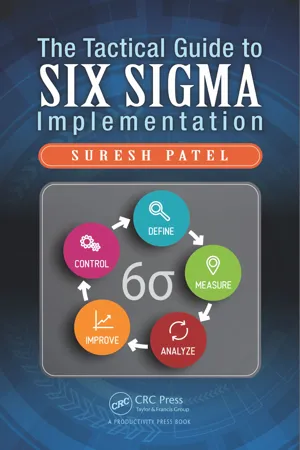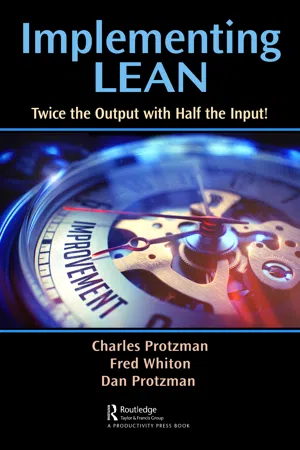DFX
DFX, or Design for X, refers to a set of methodologies aimed at optimizing product design for various factors such as manufacturability, cost, reliability, and sustainability. By considering these factors early in the design process, DFX helps to improve product quality, reduce production costs, and enhance overall efficiency. It encompasses a range of specific approaches, such as Design for Manufacturing (DFM) and Design for Assembly (DFA).
4 Key excerpts on "DFX"
- eBook - ePub
- Suresh Patel(Author)
- 2017(Publication Date)
- Productivity Press(Publisher)
...products and services that meet customer requirements. It is a cross-functional team design activity involving manufacturing, distribution, and service organizations. DFX strategy reviews design continually to find ways to improve the product. For instance, when considering serviceability and maintenance, service personnel are involved who address their requirements and concerns. Due to its use of cross-functional teams and the nature of continual review, DFX is needed within concurrent engineering (simultaneous engineering) as an approach to improve new product development where the product and associated processes are developed in parallel. Concepts and Techniques for DFX Design for Cost • Also called value engineering • Must consider price limitations Design for Manufacturability • Has the goal to design products and processes in such a way that they result in fewer problems during manufacturing • Emphasizes robustness rather than ideal performance • Reduces the probability of mistakes by reducing complexity • Designs preventive mechanisms for likely errors, such as mistake proofing or Poka Yoke • Reduces the number of parts • Reduces the number of manufacturing operations Design for Assembly • Simplifies the product into fewer parts • Makes the product easy to assemble • Reduces service, decreases time to market, and reduces repair time Sometimes design for manufacturability and design for assembly are combined (DFM/A). The benefits of integrating DFM and DFA are • Simpler designs • Fewer parts • Reduced assembly time • Reduced production cost • Fewer errors • Fewer...
- eBook - ePub
The Innovation Tools Handbook, Volume 2
Evolutionary and Improvement Tools that Every Innovator Must Know
- H. James Harrington, Frank Voehl(Authors)
- 2016(Publication Date)
- Productivity Press(Publisher)
...Is the design easy to assemble (design for manufacturability)? Will the output be easy to maintain (design for maintainability)? • Value proposition phase—How the DFX factors were considered during the creative cycle greatly influences the value related to the product design. HOW TO USE THE TOOL AT&T Bell Laboratories coined the term DFX to describe the process of designing a product to meet the above characteristics. In doing so, the life cycle cost of a product and the lowering of downstream manufacturing costs would be addressed (see Figure 7.1). The earliest stages of product realization have the greatest effect on life cycle costs, yet they represent the smallest proportion of life cycle expenditures. Gattenby and Foo, 1990 FIGURE 7.1 Design and life cycle costs. Any number of factors might be relevant to the definition of quality during a systems design initiative. DFX involves being able to incorporate a variety of X factors into a design, working toward a solution set that optimizes their interaction against customer needs and requirements. Common X factor examples include assembly, reliability, and testing. The DFX toolbox has continued to grow in number from its inception to include hundreds of tools. Some researchers in DFX technology have developed sophisticated models and algorithms. The usual practice is to apply one DFX tool at a time. DFX tools may be incorporated as part of a larger concurrent engineering, product development, process reengineering, redesign, Six Sigma, or TRIZ (theory of inventive problem solving) project. The benefits in the use of DFX that are directly related to competitiveness measures include improved quality, compressed cycle time, reduced life cycle costs, increased flexibility, improved productivity, more satisfied customers, safer workplace, and reduced environmental impacts...
- Cheryl Tulkoff, Greg Caswell(Authors)
- 2021(Publication Date)
- Wiley(Publisher)
...8 Conclusion to Design for Excellence: Bringing It All Together 8.1 Design for Excellence (DFX) in Electronics Manufacturing Designing for Excellence (DFX) is a methodology where multiple functional groups with knowledge of different parts of the product lifecycle advise the design engineering functions during the design phase. It is also the process of assessing issues beyond the base functionality, where base functionality is defined as meeting business and customer expectations of function, cost, and size. Key elements of a DFX program include designing for reliability, manufacturability, sourcing, and the environment. DFX efforts require the integration of product design and process planning into a cohesive, interactive activity known as concurrent engineering. This book's seven chapters have detailed the concept of designing a product with the best reliability so that you, as the user, can provide your customers with the life expectancy that is required. 8.2 Chapter 2: Establishing a Reliability Program This chapter provided insight into the methodology used to develop a viable reliability program within your organization. A comprehensive, well‐thought‐out reliability program ensures that companies achieve their quality, reliability, and customer satisfaction targets on time, on schedule, and within budget. Reliability is the measure of a product's ability to perform the specified function at the customer (with their use environment) over the desired lifetime. By definition, reliability is specific to each application – there is no one‐size‐fits‐all definition. There are also no universal best practices. Every company must choose the appropriate set of practices and implement a program that optimizes return on investment in reliability activities. Reliability is all about cost‐benefit; even the most successful organization has a finite budget. Since reliability activities are not a direct revenue generator, they are strongly driven by cost...
- eBook - ePub
Implementing Lean
Twice the Output with Half the Input!
- Charles W. Protzman, Fred Whiton, Daniel Protzman(Authors)
- 2018(Publication Date)
- Productivity Press(Publisher)
...Chapter 24 Lean and Engineering—DFM/A * Engineering plays a vital role, many times unknowingly, in Lean manufacturing and office transactional processes. Engineering impacts all aspects of the design, not just the product design itself. For instance, engineering must consider the following when designing new products: 1 ■ Have we standardized on the components? ■ Is it easy for the customer to service? ■ Is the new design easy to use or operate? ■ Is it easy to assemble and manufacture? ■ Is it mistake-proofed for design, service, and the customer? ■ Is it easy to procure and supply for the length of the product life cycle, or are there end-of-life issues embedded in the design? ■ Is it easy to market? Does it market itself? ■ Is it easy for total productive maintenance (TPM)? ■ Is it smart? Does it diagnose and or solve its own problems? Design for Lean (DFL): The 3P Process There are various names for designing Lean processes. The most familiar is the 3P process. The 3 Ps stands for “Product, Preparation, and Process.” This process focuses on designing the product or service (and must be cross-functional) to ensure it can start out Lean versus having to be leaned out later. It encompasses various tools: 1. Design Fishbones and process mapping 2. DFMA—design for manufacturing and assembly 3. FMEA—failure modes effects analysis 4. Transitioning the product to production 5. Target costing principles The same design process can be performed on a transactional process. Instead of parts, we may be using paper, emails, authorization and approval forms (with distances noted), etc. Design Fishbone is a process that involves literally taking each part that goes into an assembly and laying the part out on the floor in the order it is assembled. Generally, this process starts with disassembling a prototype unit (but can be a production unit if further down the design path). The unit is reassembled and then disassembled again...



